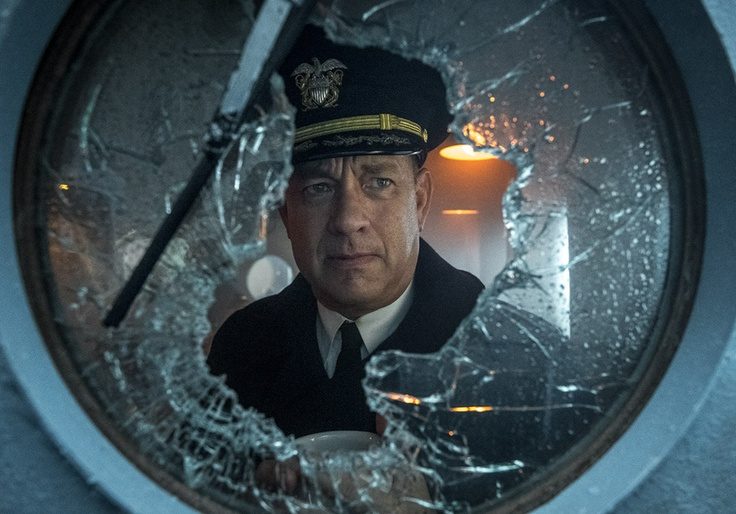I will always be grateful to Tom Hanks for wandering into a used bookstore in New York City, where (as he explained on Conan O'Brien's sensationally good podcast) he spotted a haunting dust jacket of a lone Navy captain on the deck of his destroyer as a ship burns behind him in the ocean. Hanks bought the novel that was surrounded by the jacket, and then bought the rights to it, and then spent six years writing a screenplay based on it.
The movie that has emerged from this serendipitous shopping expedition is called Greyhound, and it's good—a fast, solemn, tense war movie. But the reason I'm grateful to Hanks is also the reason I was a little disappointed by the experience of watching Greyhound on Apple TV Plus, which is the only place you can see it right now.
To perform my due diligence as a reviewer, I read the source material before I watched the movie. It's called The Good Shepherd, first published in 1955, and its author was the Tom Clancy of his day—C.S. Forester, author of the series of novels about the British naval captain Horatio Hornblower. The Good Shepherd was a major bestseller and sold to Hollywood at the time for an astonishing $200,000 (the equivalent of nearly $2 million today). I'd never read Forester before and had a vague idea that he must have been a relatively silly adventure writer. How wrong I was. The Good Shepherd is a breathtaking, technically stunning, and daring piece of writing. And what makes it so exceptional are qualities that simply cannot be duplicated on film, despite the great respect screenwriter Hanks shows for the material and the meticulous re-creation of the conditions on board a destroyer during World War II.
The novel puts us inside the head of Ernie Krause, the captain of the Keeling, a destroyer and the lead ship of a convoy of 37 boats traveling across the North Atlantic in 1942. The reader is never permitted a moment's escape from Krause's brain. The Good Shepherd takes place over 48 sleepless hours as Krause's convoy comes under attack from the Nazi submarines—the U-boats that sank nearly 4,000 Allied vessels over five years and caused the loss of more than 70,000 men in what came to be known as the Battle of the Atlantic.
This is a book about the intellectual, emotional, spiritual, and physical demands made upon those in whose hands the lives of thousands are entrusted at a moment of extreme peril. Krause, who has only reached his first command in his early 40s and who has never been in combat before, must manage the workings of his own ship, his own crew, tend to the need of the convoy, and fight the Germans. He must deal with aching legs, sore feet, cold penetrating to his every muscle, the need to use the head, famished hunger, and exhaustion that leads him nearly to fall asleep on his feet. Meanwhile, he has extraordinarily limited information about where the U-boats targeting his convoy might be, how they might maneuver, and how to answer their movements.
Most of the book's dialogue consists of Krause saying things like "Right standard rudder. Steer course two six zero." But as Forester reveals, there is a world of meaning behind those words—they involve strategy, tactics, and an effort to anticipate and outwit the enemy. Krause is emotionally inexpressive and stolid by design, striving to keep all feeling out of his voice and to maintain a manner of utter flatness—so that his commands can be immediately understood and so that those under his authority do not feel it necessary to manage his moods.
He is not an interesting man, and what he does and says is not interesting. "He was dull," Krause concludes as he loses his relentless focus on the moment to reflect ruefully on how he drove his young wife away when his prewar rise in the Navy stalls out, and she is just too young to understand the torment of his career failure. But he is, it turns out, a great man, whose dullness and disappointments—reinforced by the iron discipline he was taught by his loving pastor father and his life in the Navy—have led him to a moment at which history has called upon him to do extraordinary things. What Forester achieves in The Good Shepherd is nothing less than an authoritative portrait of how America and the Allies won World War II, because they produced heroes who had no idea they were heroes.
Hanks and his director, Aaron Schneider, do a formidable job of turning the details of the convoy's crisis as described by Forester into something visual, dramatic, and gripping. Had I not read The Good Shepherd beforehand, I might have been more engaged by it. So don't make my mistake. See Greyhound first (if you have Apple TV Plus). But I am not excusing you from the obligation of savoring Forester's achievement in prose. Read The Good Shepherd, or I will kill you.
